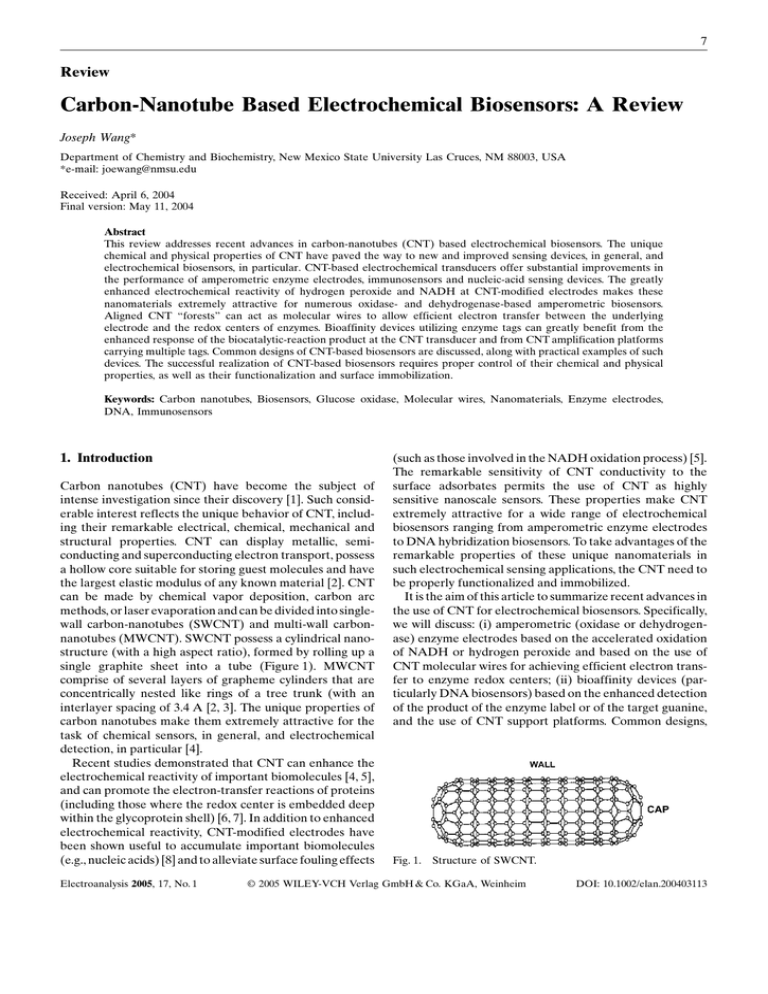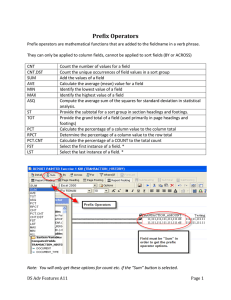Carbon-Nanotube Based Electrochemical Biosensors
advertisement

7 Review Carbon-Nanotube Based Electrochemical Biosensors: A Review Joseph Wang* Department of Chemistry and Biochemistry, New Mexico State University Las Cruces, NM 88003, USA *e-mail: joewang@nmsu.edu Received: April 6, 2004 Final version: May 11, 2004 Abstract This review addresses recent advances in carbon-nanotubes (CNT) based electrochemical biosensors. The unique chemical and physical properties of CNT have paved the way to new and improved sensing devices, in general, and electrochemical biosensors, in particular. CNT-based electrochemical transducers offer substantial improvements in the performance of amperometric enzyme electrodes, immunosensors and nucleic-acid sensing devices. The greatly enhanced electrochemical reactivity of hydrogen peroxide and NADH at CNT-modified electrodes makes these nanomaterials extremely attractive for numerous oxidase- and dehydrogenase-based amperometric biosensors. Aligned CNT “forests” can act as molecular wires to allow efficient electron transfer between the underlying electrode and the redox centers of enzymes. Bioaffinity devices utilizing enzyme tags can greatly benefit from the enhanced response of the biocatalytic-reaction product at the CNT transducer and from CNT amplification platforms carrying multiple tags. Common designs of CNT-based biosensors are discussed, along with practical examples of such devices. The successful realization of CNT-based biosensors requires proper control of their chemical and physical properties, as well as their functionalization and surface immobilization. Keywords: Carbon nanotubes, Biosensors, Glucose oxidase, Molecular wires, Nanomaterials, Enzyme electrodes, DNA, Immunosensors 1. Introduction Carbon nanotubes (CNT) have become the subject of intense investigation since their discovery [1]. Such considerable interest reflects the unique behavior of CNT, including their remarkable electrical, chemical, mechanical and structural properties. CNT can display metallic, semiconducting and superconducting electron transport, possess a hollow core suitable for storing guest molecules and have the largest elastic modulus of any known material [2]. CNT can be made by chemical vapor deposition, carbon arc methods, or laser evaporation and can be divided into singlewall carbon-nanotubes (SWCNT) and multi-wall carbonnanotubes (MWCNT). SWCNT possess a cylindrical nanostructure (with a high aspect ratio), formed by rolling up a single graphite sheet into a tube (Figure 1). MWCNT comprise of several layers of grapheme cylinders that are concentrically nested like rings of a tree trunk (with an interlayer spacing of 3.4 A [2, 3]. The unique properties of carbon nanotubes make them extremely attractive for the task of chemical sensors, in general, and electrochemical detection, in particular [4]. Recent studies demonstrated that CNT can enhance the electrochemical reactivity of important biomolecules [4, 5], and can promote the electron-transfer reactions of proteins (including those where the redox center is embedded deep within the glycoprotein shell) [6, 7]. In addition to enhanced electrochemical reactivity, CNT-modified electrodes have been shown useful to accumulate important biomolecules (e.g., nucleic acids) [8] and to alleviate surface fouling effects Electroanalysis 2005, 17, No. 1 (such as those involved in the NADH oxidation process) [5]. The remarkable sensitivity of CNT conductivity to the surface adsorbates permits the use of CNT as highly sensitive nanoscale sensors. These properties make CNT extremely attractive for a wide range of electrochemical biosensors ranging from amperometric enzyme electrodes to DNA hybridization biosensors. To take advantages of the remarkable properties of these unique nanomaterials in such electrochemical sensing applications, the CNT need to be properly functionalized and immobilized. It is the aim of this article to summarize recent advances in the use of CNT for electrochemical biosensors. Specifically, we will discuss: (i) amperometric (oxidase or dehydrogenase) enzyme electrodes based on the accelerated oxidation of NADH or hydrogen peroxide and based on the use of CNT molecular wires for achieving efficient electron transfer to enzyme redox centers; (ii) bioaffinity devices (particularly DNA biosensors) based on the enhanced detection of the product of the enzyme label or of the target guanine, and the use of CNT support platforms. Common designs, Fig. 1. Structure of SWCNT. 2005 WILEY-VCH Verlag GmbH & Co. KGaA, Weinheim DOI: 10.1002/elan.200403113 8 J. Wang oriented pyrolytic graphite (HOPC), while their open ends resemble the edge planes of HOPG. There are different ways for confining CNT onto electrochemical transducers. Most commonly this is accomplished using CNT-coated electrodes [5, 10, 11] or using CNT/binder composite electrodes [12, 13]. Details of such CNT-based transducers are giving below. Fig. 2. Hydrodynamic voltammograms for 1 mM hydrogen peroxide (A) and 1 mM NADH (B) using the graphite/Teflon (a) and CNT/Teflon (b) composite electrodes. Electrolyte, phosphate buffer (pH 7.4). (Adapted from [9] with permission.) performance characteristics, advantages, and applications of such CNT-based electrochemical biosensors are reviewed in the following sections. 2. Carbon-Nanotube Based Enzyme Electrodes Enzyme electrodes combine the specificity of enzymes with the analytical power of electrochemical devices, and are extremely useful for clinical diagnostics or environmental monitoring. The attractive low-potential detection of hydrogen peroxide and NADH (Figure 2), along with the minimal surface passivation during the oxidation of NADH, make CNT extremely attractive for oxidase- and dehydrogenase based enzyme electrodes. There are over 200 dehydrogenases and 100 oxidases. Many of these enzymes catalyze specifically the reactions of clinically important analytes (e.g., glucose, lactate, cholesterol, amino acids, urate, pyruvate, glutamate, alcohol, hydroxybutyrate) to generate the electrochemically detectable products NADH and hydrogen peroxide. Similar sensitivity and stability improvements have been illustrated for electrochemical biosensors based on other enzymes, including tyrosinase, peroxidase, organophosphorous hydrolase or alkaline phosphatase. 2.1. Common Configurations of CNT-based Amperometric Tranducers The successful realization of CNT-based biosensors requires proper control of their chemical and physical properties, as well as their functionalization and surface immobilization. The purification of CNT with oxidizing acids creates surface acid sites that are mainly carboxylic moieties. These functional groups provide sites for covalent linking of CNT to biorecognition elements (or other materials) or for their integration onto polymer surface structures. Other derivatization methods include defect and noncovalent functionalization [9]. Enzymes can be immobilized on CNT with enhanced retention of their biocatalytic activity. From the perspective of electrochemical reactivity, the side walls of CNT are suggested to have properties similar to those of the basal plane of highly Electroanalysis 2005, 17, No. 1 2.1.1.CNT-Coated Electrode Transducers One barrier for developing CNT-film based biosensing devices is the insolubility of CNT in most solvents. Earlier reported CNT-modified electrodes have thus commonly relied on casting a CNT/sulfuric acid solution onto a glassy carbon surface [5]. Nafion films have been used extensively for the construction of amperometric biosensors owing to their unique ion-exchange, discriminative and biocompatibility properties. The ability of Nafion to solubilize CNT provides a useful avenue for preparing CNT-based electrode transducers for a wide range of sensing application [10]. The resulting biosensors greatly benefit from the coupling of the antifouling/discriminative properties of Nafion films with the efficient electrocatalytic action of CNT towards hydrogen peroxide. Further improvements in the electroactivity of hydrogen peroxide (with detection limit down to 25 nM) can be obtained by dispersing platinum nanoparticles in the Nafion/CNT coating [14]. 2.1.2. Vertically Aligned Nanotube Electrode Arrays An effective CNT coating can be obtained by aligning short SWCNT normal to an electrode by self-assembly (Figure 3). Such vertically aligned SWCNT act as molecular wires to allow electrical communication between the underlying electrode and a redox enzyme [6, 7]. Such direct electron transfer between the prosthetic group of the enzyme and an electron surface obviates the need for redox mediators and is thus extremely attractive for developing reagentless sensing devices. Specific biosensing applications of these CNT forests are discussed below. Similar arrays of aligned MWCNT, grown on platinum substrates, were shown useful for amperometric enzyme electrodes [15]. The carboxylated open-ends of nanotubes were thus used for the immobilization of the enzymes, while the platinum substrate provided the signal transduction. Lin and coworkers [16] developed amperometric biosensors based on CNT-nanoelectrode ensembles (NEEs). Such NEEs consist of millions of nanoelectrodes (each of less than 100 nm in diameter), embedded in a polymerbased epoxy, on a chromium-coated silicon substrate. The enzyme was immobilized on the CNT NEE using carbodiimide chemistry by forming amide linkages between its amine residues and carboxylic acid groups on the CNT tips (Figure 4). Koehne et al. [17] fabricated low-density CNT arrays on silicon chips using a bottom-up approach, involving lithographic patterning, metallization of the electrical contacts, deposition of a catalyst and CNT growth by plasma 2005 WILEY-VCH Verlag GmbH & Co. KGaA, Weinheim Carbon-Nanotube Based Electrochemical Biosensors enhanced chemical vapor deposition. Its applicability to DNA detection is described below. 2.1.3. CNT-based Biocomposite Electrodes An attractive avenue for preparing CNT-based amperometric enzyme electrodes involves CNT/insulator/enzyme biocomposites [12, 13, 18]. Conventional carbon-paste composites have been widely used for the design of renew- Fig. 3. Nanoforest of vertically aligned CNT ”trees” acting as molecular wires. (Adapted from [6] with permission.) 9 able amperometric enzyme electrodes [19]. Britto et al. prepared a composite electrode based on mixing MWCNT and bromoform as a binder [20]. Carbon-nanotube paste enzyme electrodes were prepared by mixing CNT with mineral oil [13, 18]. Such composite electrodes combines the ability of carbon nanotubes to promote electron-transfer reactions with the attractive advantages of paste electrode materials. We reported on the preparation of a binderless biocomposite based on mixing an enzyme (GOx) within CNT [21]. The resulting biocomposite was packed within a needle and was used as a microsensor for glucose (see more details below). Another simple avenue for preparing effective CNT-based electrochemical biosensors involves the use of CNT/Teflon composite materials [12]. These biocomposite devices rely on the use of CNT as the sole conductive component of the transducer rather than utilizing it as the modifier in connection to another electrode surface. The bulk of the resulting CNT/Teflon electrodes serves as a “reservoir” of the enzyme. As illustrated in Figure 2, the strong electrocatalytic activity of CNT towards hydrogen peroxide or NADH is not impaired by their association with the Teflon binder. Screen-printed strip electrodes, based on thick-film microfabrication, offer large scale mass production of highly reproducible low-cost electrochemical biosensors. We have demonstrated that CNT-based inks are highly suitable for the microfabrication of thick-film electrochemical sensors [22]. Such screen-printed CNT sensors have a well-defined appearance, are mechanically stable (with good resistance Fig. 4. Fabrication of a glucose biosensor based on CNT nanoelectrode ensembles: A) Electrochemical treatment of the CNT nanoelectrode assembly for functionalization. B) Coupling of GOx to the CNT nanoelectrode ensembles. (Adapted from [16] with permission.) Electroanalysis 2005, 17, No. 1 2005 WILEY-VCH Verlag GmbH & Co. KGaA, Weinheim 10 J. Wang to mechanical abrasion), and exhibit higher electrochemical reactivity (compared to conventional carbon strips). The resulting devices thus combine the attractive advantages of CNT materials and screen-printed electrodes, offer improved performance compared to strips fabricated with conventional carbon inks, and open the door for a wide range of sensing applications. 2.2. CNT-Based Oxidase Biosensors 2.2.1. Monitoring of Glucose The diagnosis and management of diabetes mellitus requires a tight monitoring of blood glucose levels. Electrochemical biosensors for glucose play a leading role in this direction. The dramatic decrease in the overpotential of hydrogen peroxide as well as the direct electron transfer of glucose oxidase (GOx) observed at CNT-modified electrodes indicate great promise for the biosensing of glucose. CNT/Nafion/GOx-coated electrodes, coupling the electrocatalytic detection of hydrogen peroxide with the permselectivity of Nafion offered a highly selective low-potential ( 0.05 V vs. Ag/AgCl) biosensing of glucose [10]. The resulting biosensor offered an effective discrimination against both neutral and anionic redox constituents The deposition of platinum nanoparticles onto Nafion-containing CNT/GOx film led to higher sensitivity compared to devices based on CNT or Pt-particles alone [14]. This sensor offered a detection limit of 0.5 mM glucose, high selectivity and a response time of 3 s. Wallaces group [23] reported on glucose biosensors based on aligned CNT coated with inherently conducting polymer. This resulted in the formation of a bioactive conducting coaxial sheath around the individually aligned CNT, and led to an attractive low-potential detection of the liberated hydrogen peroxide. Wang and Musameh designed a needle microsensor for amperometric monitoring of glucose based on packing of a binderless CNT-GOx composite within a 21-gauge needle [21]. The resulting microsensor offered a low-potential highly selective and sensitive detection of glucose. The high sensitivity and selectivity were coupled to a wide linear range (up to 35 mM), prolonged lifetime and oxygen independence. A similar highly selective and sensitive glucose response was obtained using CNT-paste enzyme electrode [13]. No interference was observed at 0.1 V in the presence of excess ascorbic acid, uric acid and acetaminophen. A linear response up to 30 mM glucose was also reported, along with a detection limit of 0.6 mM. Lin and coworkers [16] reported on glucose biosensors based on CNT nanoelectrode ensembles (Figure 4). The low-potential ( 0.2 V vs. SCE) reductive detection of the hydrogen peroxide product led to highly selective amperometric monitoring of the glucose substrate, along with linearity up to 30 mM glucose and a detection limit of 0.08 mM. Davis et al. [2] described briefly a SWCNT glucose biosensor based on a diffusive ferrocene mediator. Electroanalysis 2005, 17, No. 1 Fig. 5. Schematic picture of two electrodes connecting a semiconducting SWCNT with GOx enzymes immobilized on its surface. (Adapted from [24] with permission.) The redox process of the GOX FAD moiety was communicated to the CNT p system through the ferrocene mediator to generate a quantifiable catalytic current. Besteman et al. [24] reported on a SWCNT transistor as a conductivity glucose biosensor (Figure 5). Controlled attachment of GOx to the SWCNT sidewall was achieved through a linking molecule. Such immobilization led to decreased conductivity. The enzyme-coated tube acted as a reversible pH sensor and displayed increase in the conductance upon adding glucose (while applying a gate voltage between a standard reference electrode and the semiconducting SWCNT). Ye et al. [25] reported on the nonenzymatic detection of glucose at a well-aligned MWCNT-modified electrode. The surface-confined CNT layer displayed a strong electrocatalytic activity towards glucose in alkaline media, to allow convenient amperometric monitoring at þ0.2 Vover the 0 –20 mM range. 2.2.2. Other CNT-Oxidase Biosensors Reliable monitoring of lactate is essential for clinical diagnostics, sport medicine, biotechnology or food analysis. Rubianes and Rivas [26] described a CNT/mineral-oil paste, containing lactate oxidase, for amperometric monitoring of lactate. The accelerated electron transfer reaction of hydrogen peroxide at the CNT-based paste electrode offered a rapid low-potential ( 0.10 V) detection of the substrate. A similar CNT/mineral-oil paste configuration containing polyphenol oxidase was employed for amperometric monitoring of polyphenolic compounds. High sensitivity was observed, reflecting the CNT-induced electrocatalytic detection of the enzymatically generated catechol-quinone. 2.3. CNT-Promoted Direct Electron Transfer of GOX and other Enzymes The possibility of direct electron-transfer between CNTand GOx paves the way for the construction of amperometric glucose biosensors. Such electrical communication with GOx (and other oxidoreductase enzymes) would obviate the need for a co-substrate and allow efficient transduction of the biorecognition event. The redox center of glucose oxidase, like those of most oxidoreductases, are electrically insulated by a protein shell. Because of this glycoprotein shell, the enzyme cannot be 2005 WILEY-VCH Verlag GmbH & Co. KGaA, Weinheim 11 Carbon-Nanotube Based Electrochemical Biosensors oxidized or reduced at an electrode at any potential. Guiseppi-Elie et al. [27] reported on the direct electron transfer between SWCNT and the redox center of adsorbed GOx. Both FAD and GOx were found to spontaneously adsorb to annealed CNT that were cast onto the glassycarbon surface to display quasi-reversible one-electron transfer. Similarly, GOx was found to spontaneously adsorb to annealed SWCNT and to display a quasi-reversible oneelectron transfer. It was assumed that the tubular fibrils become positioned within a tunneling distance of the cofactors with little consequence to denaturation. Willners group [28] demonstrated that aligned reconstituted GOx on the edge of SWCNT can be linked to an electrode surface (Figure 6). The electrons were transported along distances higher than 150 nm with the length of the SWCNT controlling the rate of electron transport. Interfacial electron transfer rate constants of 42 and 19 s1 were estimated for 50 and 100 nm long SWCNT, respectively. Such enzyme reconstitution on the end of CNTrepresents an extremely efficient approach for plugging an electrode into GOx. Luong et al. [11] reported on the promoted electron transfer of GOx at MWCNT-modified glassy-carbon electrode. The sensor fabrication relied on the use of 3aminopropyltriethoxysilane (APTES) for solubilizing and immobilizing the CNT. The resulting surface acts like bundled ultramicroelectrodes that facilitate access to the active FAD site and a direct electron transfer. Cyclic voltammograms for GOx immobilized on the APTES/ MWNCT layer modified glassy are displayed in Figure 7. Nearly symmetrical peaks, with similar peak potentials, close to those of FAD are observed. Gooding [6] and Rusling [7] reported that aligned CNT (forests) can act as molecular wires to allow electrical communication between the underlying electrode and redox proteins (covalently attached to the ends of the SWCNT). Their data indicate that “trees” of CNT in the nanoforest behave electrically similar to a metal, conducting electrons from an external circuit to the redox sites of enzymes, and providing bioelectrocatalytic activity that can be utilized in biosensing devices. Fig. 7. Direct electron transfer of GOx at a CNT-modified electrode. Cyclic voltammograms for GOx on APTES/Nafion/ MWCNT-modified glassy-carbon electrode at different scan rates: 20 – 80 mV/s (A – D). (Adapted from [12] with permission.) Fig. 6. Assembly of the SWCNT electrically-contacted glucose oxidase electrode. (Adapted from [28] with permission.) Electroanalysis 2005, 17, No. 1 2005 WILEY-VCH Verlag GmbH & Co. KGaA, Weinheim 12 J. Wang 2.4. CNT-Based Dehydrogenase Biosensors 2.5. CNT-Based Peroxidase and Catalase Biosensors Reagentless amperometric devices based on the coimmobilization of dehydrogenase enzymes and their nicotinamide adenine dinucleotide (NADþ) cofactor to various solid electrodes are commonly employed for the biosensing of important substrates such as lactate, alcohol or glucose. The oxidation of the NADH product serves as the anodic signal and regenerate the NADþ cofactor. Problems inherent to such anodic detection are the large overvoltage encountered for NADH oxidation at ordinary electrodes [29] and surface fouling associated with the accumulation of reaction products [30]. CNT-modified electrodes are particularly useful for addressing these problems as they offer an accelerated electron transfer of NADH along with minimization of surface fouling [5]. As indicated from Figure 8, the CNTmodified electrodes exhibit a substantial negative shift of the anodic peak potential and increased current signal. The catalytic activity is evident from the defined peaks at þ 0.33 V (B; MWCNT) and þ 0.36 V (C; SWCNT). Wang and Musameh [31] reported on a CNT-based ethanol amperometric biosensor based on the coimmobilization of ADH and its NADþ cofactor within the CNT/Teflon matrix. The marked decrease in the overvoltage for the oxidation of the liberated NADH facilitated convenient low-potential stable detection of the ethanol. Similar advantages are expected in connection to the biosensing of lactate or glucose in connection with lactate or glucose dehydrogenases, respectively. Peroxidases are a group of enzymes catalyzing the oxidation of various electron donors by hydrogen peroxide or alkyl peroxides. Ruslings group demonstrated the electrochemistry manifested horseradish- peroxidase (HRP) activity at SWCNT forests [7]. Quasi-reversible Fe(III)/Fe(II) voltammetry was observed around 0.25 V (vs. SCE) for the HRP coupled to the carboxylated ends of the CNT forest (though an amide linkage). The resulting HRP peroxide biosensor offered a detection limit of 100 nM. Yamamoto et al. reported on a highly selective biosensor for on-line monitoring of hydrogen peroxide [32]. For this purpose, MWCNTs were successfully immobilized on the surface of a glassy-carbon flow detector by mixing with HRP. High selectivity was obtained by monitoring the reduction current at 0.30 V, along with a detection limit of 100 nM. Xu et al. [33] developed a hydrogen peroxide biosensor based on the attractive characteristics of the carbon nanotube. The device relied on the coimmobilization of HRP and the methylene blue (MB) mediator on the CNT-coated electrode, with MB acting as electron carrier between the enzyme and the surface. The response to hydrogen peroxide was linear up to 2 mM and had a detection limit of 1 mM. Zhou and coworkers [34] reported on the direct electrochemistry of catalase at SWCNT-modified gold electrodes. A well-defined redox process corresponding to the Fe(III)/ Fe(II) redox center was observed around 0.4 V. The peak current increased with the enzyme concentration over the micromolar range. The catalase/SWCNT modified electrode displayed a characteristic catalytic wave upon addition of hydrogen peroxide. 2.6. Miscellenous Enzyme Electrodes Based on CNT Lin et al. [35] employed a CNT-modified screen-printed electrode for amperometric detection of organophosphorous pesticides. The disposable biosensor relied on the inhibition of acetylcholinesterase and the CNT-promoted detection of the hydrogen peroxide of the co-immobilized choline oxidase. We demonstrated the improved amperometric biosensing of organophosphorous substrates of organophosphorous hydrolase (OPH) through the enhanced electrochemical reactivity of its p-nitrophenol product [36]. The higher sensitivity was coupled to improved stability, associated with the minimization of surface fouling that occurred during the oxidation of the phenolic product. 3. Carbon-Nanotube Based Electrochemical DNA Sensors Fig. 8. Cyclic voltammograms for 5 mM NADH at unmodified (A), MWCNT-modified (B) and SWCNT-modified (C) glassy carbon electrodes. Scan rate, 50 mV/s; electrolyte, phosphate buffer (pH 7.4). (Adapted from [5] with permission.) Electroanalysis 2005, 17, No. 1 DNA biosensors, based on nucleic acid recognition processes, are rapidly being developed towards the goal of rapid, simple and inexpensive testing of genetic and infectious diseases. Electrochemical hybridization biosensors rely on the immobilization of a single-stranded (ss-) DNA probe 2005 WILEY-VCH Verlag GmbH & Co. KGaA, Weinheim Carbon-Nanotube Based Electrochemical Biosensors onto the transducer surface that converts the duplex formation into a useful electrical signal [37]. The performance of such devices can greatly benefit from the use of CNT. Such improvements are attributed to enhanced detection of the target guanine or of the product of an enzyme label, as well as to the use of CNT carrier platforms. Surface-confined MWCNT have been shown useful to facilitate the adsorptive accumulation of the guanine nucleobase and greatly enhances its oxidation signal [8]. This advantage of CNT-coated glassy-carbon electrodes have been illustrated from comparison to the common unmodified glassy carbon, carbon paste and graphite pencil electrodes. The dramatic amplification of the guanine signal has been combined with a label-free electrical detection of DNA hybridization. A similar enhancement of the guanine DNA response was reported at MWCNT paste electrodes [38] and at a SWCNT-coated glassy-carbon electrode [39]. Trace (mg/L) of nucleic acids have thus been detected following short accumulation times. An array of vertically aligned MWCNT, embedded in SiO2 (Figure 9), has been shown useful for ultrasensitive 13 detection of DNA hybridization [40]. Subattmoles of DNA targets have been measured by combining the CNT nanoelectrode array with Ru(bpy) 2þ 3 -mediated guanine oxidation. Such CNT array was also applied for label-free detection of DNA PCR amplicons, and offered the detection of less than 1000 target amplicons [16]. A lower nanotube density offered higher sensitivity. Improved sensitivity of electrical DNA hybridization has been reported also in connection to the use of daunomycin redox intercalator [41]. A MWCNT-COOH modified glassy carbon was used for this task along with a 5’-amino group functionalized oligonucleotide probe and pulse-voltammetric transduction. Highly sensitive bioelectronic protocols for detecting of proteins and DNA were described recently based on the coupling of several CNT-derived amplification processes [42]. In these procedures CNT played a dual amplification role in both the recognition and transduction events, namely as carriers for numerous enzyme tags and for accumulating the a-naphthol product of the enzymatic reaction (Figure 10). A coverage of around 9600 enzyme molecules per a Fig. 9. Use of CNT electrode array for sensitive detection of DNA hybridization. Schematic mechanism of the Ru(bpy) 2þ 3 mediated guanine oxidation. (Adapted from [40] with permission.) Fig. 10. CNT-derived amplification of the recognition and transduction events. A) Capture of the alkaline-phosphatase (ALP)-loaded CNT tags to the streptavidin-modified magnetic beads by the DNA or antibody recognition events; B) addition of the substrate and enzymatic reaction; C) electrochemical detection of the product of the enzymatic reaction at CNT-modified glassy carbon electrode. (Adapted from [42] with permission.) Electroanalysis 2005, 17, No. 1 2005 WILEY-VCH Verlag GmbH & Co. KGaA, Weinheim 14 CNT (i.e., binding event) was estimated. Such CNT-derived double-step amplification pathway (of both the recognition and transduction events) allows the detection of DNA and proteins down to 1.3 and 160 zmol, respectively, in 25 – 50 mL samples and indicates great promise for PCR-free DNA analysis. Cai et al. [43] described an indicator-free AC impedance measurements of DNA hybridization based on DNAprobe-doped polypyrrole film over a MWCNT layer. The hybridization event led to a decrease of impedance values reflecting the reduction of the electrode resistance. A 5-fold sensitivity enhancement was observed compared to analogous measurements without CNT. 4. Conclusions This review has addressed recent advances in the application of CNT for electrochemical biosensing. The attractive properties of CNT have paved the way for the construction of a wide range of electrochemical biosensors exhibiting an attractive analytical behavior. The marked electrocatalytic activity towards hydrogen peroxide and NADH permits effective low-potential amperometric biosensing of numerous important substrates. The enhanced electrochemical reactivity is coupled to resistance to surface fouling and hence to high stability. The use of CNT molecular wires offers great promise for achieving efficient electron transfer from electrode surfaces to the redox sites of enzymes. Better control of the chemical and physical properties of CNT and understanding of their use as molecular wires should lead to more efficient electrical sensing devices. Electrochemical DNA biosensors can greatly benefit from the use of CNT support platforms and from the enhanced detection of the product of the enzyme label or the target guanine. Such developments suggest that future interdisciplinary efforts could yield new generations of CNT-based biosensors for a wide range of applications. It is thus fair to say that the real biosensing opportunities of CNT still lie in the future. 5. Acknowledgements The author thanks NSF (Awards CHE 0209707) and EPA (Award RD830900) for supporting studies on nanomaterialbased biosensors. 6. References [1] C. N. Rao, B. C. Satishkumar, A. Govindaraj, M. Nath, ChemPhysChem. 2001, 79. [2] J. J. Davis, K. Coleman, B. Azamian, C. Bagshaw, M. L. Green, Chem. Eur. J. 2003, 9, 3732. [3] R. H. Baughman, A. Zakhidov, W. A. de Heer, Science 2002, 297, 787. [4] Q. Zhao, Z. Gan, Q. Zhuang, Electroanalysis 2002, 14, 1609. Electroanalysis 2005, 17, No. 1 J. Wang [5] M. Musameh, J. Wang, A. Merkoci, Y. Lin, Electochem. Commun. 2002, 4, 743. [6] J. J. Gooding, R. Wibowo, J. Q. Liu, W. Yang, D. Losic, S. Orbons, F. J. Mearns, J. G. Shapter, D. B. Hibbert, J. Am. Chem. Soc. 2003, 125, 9006. [7] X. Yu, D. Chattopadhyay, I. Galeska, F. Papadimitrakopoulos, J. F. Rusling, Electochem. Commun. 2003, 5, 408. [8] J. Wang, A. Kawde, M. Mustafa, Analyst 2003, 128, 912. [9] A. Hirsch, Angew. Chemie Int. Ed. 2002, 41, 1853. [10] J. Wang, M. Musameh, Y. Lin, J. Am. Chem. Soc. 2003, 125, 2408. [11] J. H. Luong, S. Hrapovic, D. Wang, F. Bensebaa, B. Simard, Electroanalysis 2004, 16, 132. [12] J. Wang, M. Musameh, Anal. Chem. 2003, 75, 2075. [13] M. D. Rubianes, G. A. Rivas, Electrochem. Commun. 2003, 5, 689. [14] S. Hrapovic, Y. Liu, K. Male, J. H. Luong, Anal. Chem. 2004, 76, 1083. [15] S. Sotiropoulo, N. A. Chaniotakis, Anal. Bioanal. Chem. 2003, 375, 103. [16] Y. Lin, F. Lu, Y. Tu, Z. Ren, Nano Letters 2004, 2, 191. [17] J. Koehne, H. Chen, J. Li, A. Cassell, Q. Ye, H. Ng, M. Meyyappan, Nanotechnology 2003, 14, 1239. [18] F. Valentini, A. Amine, S. Orlanducci, M. Terranova, G. Palleschi, Anal. Chem. 2003, 75, 5413. [19] L. Gorton, Electroanalysis 1995, 7, 23. [20] P. J. Britto, K. S.V. Santhanam, P. M. Ayajan, Bioelectrochem. Bioenerg. 1996, 41, 121. [21] J. Wang, M. Musameh, Analyst 2003, 128, 1382. [22] J. Wang, M. Musameh, Analyst 2004, 129, 1. [23] M. Gao, L. Dai, G. G. Wallace, Electroanalysis 2003, 15, 1089. [24] K. Besteman, J. Lee, F. Wiertz, H. Heering, C. Dekker, Nano Letters 2003, 3, 727. [25] J. Ye, Y. Wen, W. D. Zhang, L. M. Gan, G. Xu, F. S. Sheu, Electrochem. Commun. 2004, 6, 66. [26] M. D. Rubianes, G. A. Rivas, this issue Electroanalysis 2004. [27] A. Guiseppi-Elie, C. Lei, R. Baughman, Nanotechnology 2002, 13, 559. [28] F. Patolsky, Y. Weizmann, I. Willner, Ange, w Chem. Int. Edition 2004, 43, 2113. [29] M. J. Lobo, A. J. Miranda, P. Tunon, Electroanalysis 1997, 9, 191. [30] J. Wang, L. Angnes, T. Martinez, Bioelectrocem. Bioenerg. 1992, 29, 215. [31] J. Wang, M. Musameh, Anal. Lett. 2003, 36, 2041. [32] K. Yamamoto, G. Shi, T. S. Zhou, F. Xu, J. M. Xu, T. Kato, J. Y. Jin, L. Jin, Analyst 2003, 128, 249. [33] J. Z. Xu, J. J. Zhu, Q. Wu, Z. Hu, H. Y. Chen, Electroanalysis 2003, 15, 219. [34] L. Zhou, J. Wang, F. Zhou, Electroanalysis 2004, 16, 672. [35] Y. Lin, F. Lu, J. Wang, Electroanalysis 2004, 16, 145. [36] R. Deo, J. Wang, I. Block, F. Scholz, A. Mulchandani, W. Chen, Y. Lin, in press. [37] J. J. Gooding, Electroanalysis 2002, 14, 1149. [38] M. Pedano, G. A. Rivas, Electrochem. Commun. 2004, 6, 10. [39] J. Wang, M. Li, Z. Shi, N. Li, Z. Gu, Electroanalysis 2004, 16, 140. [40] J. Li, H. T. Ng, A. Cassell, W. Fan, H. Chen, Q. Ye, J. Koehne, M. Meyyappan, Nano Letters 2003, 3, 597. [41] H. Cai, X. Cao, Y. Jiang, P. He, Y. Fang, Anal. Bioanal. Chemistry 2003, 375, 287. [42] J. Wang, G. Liu, M. Jan, J. Am. Chem. Soc. 2004, 126, 3010. [43] H. Cai, Y. Xu, P. He, Y. Z. Fang, Electroanalysis 2003, 15, 1864. 2005 WILEY-VCH Verlag GmbH & Co. KGaA, Weinheim





